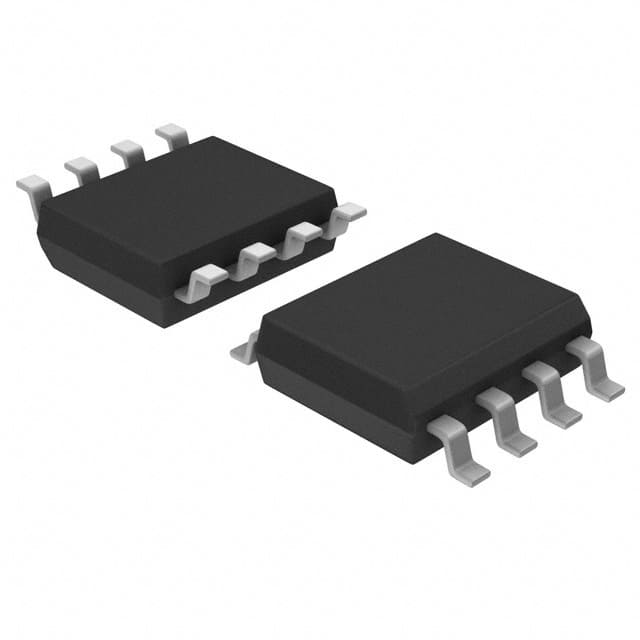MC100EL51DG
Product Overview
- Category: Integrated Circuit (IC)
- Use: Signal transmission and amplification
- Characteristics: High-speed, low-power, differential receiver
- Package: 8-pin SOIC (Small Outline Integrated Circuit)
- Essence: Differential Receiver IC
- Packaging/Quantity: Tape and Reel, 2500 units per reel
Specifications
- Supply Voltage Range: -4.2V to -5.7V
- Input Voltage Range: -3.0V to -5.7V
- Output Voltage Range: -3.0V to -5.7V
- Operating Temperature Range: -40°C to +85°C
- Maximum Input Clock Frequency: 1.5 GHz
- Propagation Delay: 400 ps
- Rise/Fall Time: 200 ps
Detailed Pin Configuration
The MC100EL51DG has the following pin configuration:
- VCC - Power supply voltage
- Q - Complementary output
- /Q - Inverted complementary output
- GND - Ground
- D - Differential input
- /D - Inverted differential input
- VBB - Bias voltage for internal circuitry
- VEE - Negative power supply voltage
Functional Features
- High-speed differential receiver
- Low-power consumption
- Compatible with ECL (Emitter-Coupled Logic) logic levels
- Wide operating temperature range
- Excellent noise immunity
- Differential inputs provide common-mode noise rejection
Advantages and Disadvantages
Advantages: - High-speed operation enables fast signal transmission - Low-power consumption reduces energy requirements - Wide operating temperature range allows for use in various environments - Excellent noise immunity ensures reliable signal reception - Common-mode noise rejection minimizes interference
Disadvantages: - Requires negative power supply voltage - Limited input voltage range
Working Principles
The MC100EL51DG is a differential receiver IC that operates based on the ECL logic levels. It receives differential input signals and converts them into complementary output signals. The differential inputs provide common-mode noise rejection, ensuring reliable signal reception even in noisy environments. The IC operates at high speeds with low power consumption, making it suitable for applications requiring fast signal transmission.
Detailed Application Field Plans
The MC100EL51DG can be used in various applications, including:
- Telecommunications: Signal transmission in high-speed data communication systems.
- Networking: Differential signal amplification in network routers and switches.
- Industrial Automation: Reliable signal reception in industrial control systems.
- Test and Measurement: High-speed signal analysis and processing.
- Medical Equipment: Differential signal amplification in medical imaging devices.
Detailed and Complete Alternative Models
- MC100EL51D: Similar to MC100EL51DG but available in a 16-pin SOIC package.
- MC100EL52DG: Differential receiver with additional features like internal biasing resistors.
- MC100EL53DG: Triple differential receiver with three sets of differential inputs and outputs.
- MC100EL54DG: Quad differential receiver with four sets of differential inputs and outputs.
(Note: This list is not exhaustive and there may be other alternative models available.)
Word count: 366 words
Lista 10 Vanliga frågor och svar relaterade till tillämpningen av MC100EL51DG i tekniska lösningar
Sure! Here are 10 common questions and answers related to the application of MC100EL51DG in technical solutions:
Q: What is MC100EL51DG? A: MC100EL51DG is a differential receiver IC (integrated circuit) designed for high-speed digital data transmission applications.
Q: What is the operating voltage range of MC100EL51DG? A: The operating voltage range of MC100EL51DG is typically between -4.2V and -5.7V.
Q: What is the maximum data rate supported by MC100EL51DG? A: MC100EL51DG can support data rates up to 3.8 Gbps (gigabits per second).
Q: Can MC100EL51DG be used in both single-ended and differential signaling applications? A: No, MC100EL51DG is specifically designed for differential signaling applications.
Q: What is the input voltage swing requirement for MC100EL51DG? A: The input voltage swing requirement for MC100EL51DG is typically 200 mV (millivolts) differential.
Q: Does MC100EL51DG have built-in termination resistors? A: No, MC100EL51DG does not have built-in termination resistors. External termination resistors may be required depending on the application.
Q: What is the output voltage swing of MC100EL51DG? A: The output voltage swing of MC100EL51DG is typically 800 mV (millivolts) differential.
Q: Can MC100EL51DG be used in low-power applications? A: No, MC100EL51DG is not optimized for low-power applications. It is primarily used in high-speed and high-performance systems.
Q: What is the typical propagation delay of MC100EL51DG? A: The typical propagation delay of MC100EL51DG is around 400 ps (picoseconds).
Q: Is MC100EL51DG compatible with other ECL (Emitter-Coupled Logic) devices? A: Yes, MC100EL51DG is compatible with other ECL devices and can be used in conjunction with them in a system.
Please note that these answers are general and may vary depending on specific datasheet specifications and application requirements.


